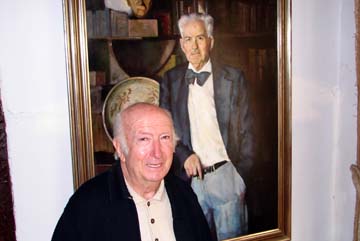
Pío Caro Baroja before a portrait of his brother Julio. Taken from Euskonews.
It was not long ago that Pío Caro Baroja passed away in his Málaga home. Guardian of the family memory and Itzea, the property acquired by his uncle Pío in 1912, he devoted himself to documentary making. He also turned to writing and editing works of diverse nature.
These are the last words of Navarra. Las cuatro estaciones [Navarre. The four seasons], one of Caro Baroja’s most outstanding documentary films: “Todo pasa en el mundo, no sólo desaparecen los hombres formando generaciones, también se van las costumbres, los ritos, las creencias se transforman, las técnicas, no sabemos si para bien o para mal. En todo caso, el día de difuntos en las sepulturas de las parroquias rurales lucen las argizaiolak, pero los hombres modernos también tenemos la obligación de honrar a nuestros muertos y sus costumbres y Navarra puede y debe dar ejemplo recogiendo todas las reliquias de su pasado milenario.” (Nothing stays in this world; not only do people and generations disappear, but customs, rites, beliefs and practices change, for better or for worse. On All Saints’ Day candles are still lit at the symbolic graves in rural churches; nevertheless; we modern people too ought to honour our dead and their habits, and Navarre can and must lead by example, collecting vestiges of its millennial past.)
Looking at the rapid transformation of rural society, condemned to lose its trades, ways and traditions, and in collaboration with NO-DO (Noticiarios y Documentales – News and Documentary Films) and the production company founded by him and his brother Julio Caro Baroja, Documentales Folclóricos de España – Documentary Films on Spanish Folklore, Pío Caro directed historical and ethnographic documentaries such as: Los diablos danzantes de Almonacid del Marquesado [The dancing devils of Almonacid del Marquesado] (1964), El carnaval de Lanz [Lantz Carnival] (1964), La Virgen de la Peña [The Virgen de la Peña pilgrimage] (1964) or Las botargas [Magical characters known as ‘botargas’] (1965). Filmed for the second national television channel, and during the same decade, we could mention among others Deportes vascos [Basque sports], El valle de Iraurgui [The Valley of Iraurgi] (1966), Bertsolaris [Basque ‘bertso’ singers] (1967), Las traineras [Traditional rowing boats or ‘traineras’] (1967) or La Javierada [The Javierada pilgrimage] (1968).
His two chief projects were shot in the following decade, also in collaboration with his brother: Navarra. Las cuatro estaciones (1970-1972), for the Institución Príncipe de Viana – Prince of Viana Institution, and Gipuzkoa (1976-1979), for the Caja de Ahorros Municipal de San Sebastián banking entity.
Navarra. Las cuatro estaciones gathers the main distinctive features of the annual cycle in Navarre: traditional agricultural tools and their craftsmanship, farming and harvesting, festivals and celebrations, carnivals and other expressions of rural folklore. Many passages are of great interest; however, and among all, let us highlight the scenes formerly produced by the NO-DO newsreels and dedicated to Lantz Carnival. The 50th anniversary of its recovery, that had been made possible through the efforts of the Caro Baroja brothers, was commemorated in 2014.
In the documentary Gipuzkoa, divided into eight chapters –man, stone, meadows, the tree, rural life, iron, the sea and rural locations–, customs, traditions and practices of an ancient people are outlined.
As Roldán Larreta states: “Ahí queda para el futuro de la cultura vasca un mundo fijado en celuloide lleno de formas mágicas y tradiciones ancestrales gracias a la labor de un cineasta incomprendido en su tiempo”. (There it remains on celluloid film for future generations a world filled with magical forms and ancestral traditions thanks to the labour of a film-maker who was misunderstood and unacknowledged by his contemporaries.)
Naiara Ardanaz – Etniker Navarre – Etniker Euskalerria Groups
Translated by Jaione Bilbao – Language Department – Labayru Fundazioa